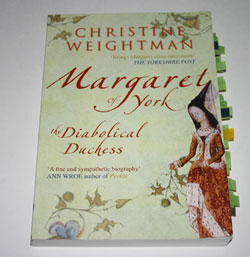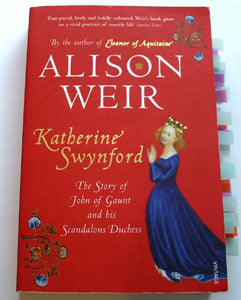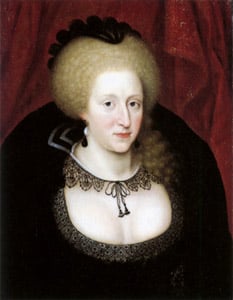Book Review : She Wolves
Posted on
Last Christmas I got a lovely collection of history books, and I've recently re-read one by Elizabeth Norton. The full title of this book is "She Wolves: The Notorious Queens of England", and as you can probably tell it focuses on a cross-section of England's Queens. You won't find anything about Adeliza of Louvain or Jane Seymour in this book, instead Elizabeth Norton focuses on those Queens whose terrible reputation has been maintained down the centuries.
This book is divided in to several parts and from there in to chapters under titles such as "Incestuous Queens", "Arrogance & Pride" and "Witchcraft".  Some of these chapters encapsulate several Queens in one go, others are dedicated purely to one woman (such as "Witchcraft" which is about Joan of Navarre). Each part includes an introduction of a few pages before delving in to the chapters themselves, in total 19 Queens are analysed and discussed in this book, starting with the Anglo-Saxons and finishing with Mary I.
Some of these chapters encapsulate several Queens in one go, others are dedicated purely to one woman (such as "Witchcraft" which is about Joan of Navarre). Each part includes an introduction of a few pages before delving in to the chapters themselves, in total 19 Queens are analysed and discussed in this book, starting with the Anglo-Saxons and finishing with Mary I.
The book itself is an interesting read. Norton sets the Queens out in proper chronological order, which I much prefer over jumping backwards and forwards across centuries. Along with setting the background of each Queen discussing their actions, Norton also gives explanations for their actions and for the hostility of our sources. For readers that aren't used to reading about the medieval world, it brings you firmly out of the modern mentality of "women can do anything", and reminds you that while these women COULD do anything, they weren't actually supposed to.
I also like that Norton didn't just jump straight into post-Conquest England and instead wrote about some Anglo-Saxon Queens. While many people think that the English monarchy began solely with William the Conqueror, in reality there were plenty of Anglo-Saxon kings. The major problem with this is that Queens are generally ignored by the sources in those times, unless they were "Bad Queens". By including them, Norton reminds us that there were notorious Queens before 1066.
While I mostly enjoyed reading this book, where was something about it that just didn't sit right with me. For example in her summing up of Elizabeth Woodville she describes her as a "wailing Cassandra". Since Cassandra was a rather ineffective Greek "heroine", this epithet effectively casts Elizabeth Woodville in to the role of passive bystander, when in reality we know that she frequently took control of her own life and plotted against two Kings. It feels that with some of these women she is very quick to condemn them, and with others she takes all responsibility for their actions out of the women's hands, and places it firmly with the men in their lives.
Being pedantic I also dislike the minor inconsistency of the chapter titles. As said above, each chapter has a title such as "Witchcraft", with the exception being the chapter about Anne Boleyn. It's only a small thing, but it just seems a bit lazy, as if a new title just wasn't possible when "Witchcraft" and "The Seductress" had been taken by others.
Finally I felt that this book was just a bit too short. At 242 pages for these women it certainly isn't short, and yet several of the chapters seemed rather short for women who had led such varied and interesting lives.
Overall I think this is a good read, but perhaps it's better off as an introduction to some of England's Queens, than as a book for those of us who have already read plenty of other titles on the subject.

 untries for a while, but it still seemed like a silly thing to me, probably becase I reuse my carrier bags constantly in supermarkets and then reuse them again as bin liners when they're coming to the end of their life.
untries for a while, but it still seemed like a silly thing to me, probably becase I reuse my carrier bags constantly in supermarkets and then reuse them again as bin liners when they're coming to the end of their life.
 In the end Young Henry, fed up with being treated like a child and egged-on by his father-in-law, the King of France, rebelled against his father in 1173 along with his brothers and his mother Eleanor. They failed, Young Henry and his brothers managed to escape the situation with a few new castles, Eleanor of Aquitaine was locked up. But in the end it wasn't enough and Young Henry rebelled again in 1183. He contracted dysentry while on campaign against his father, and died on 11th June 1183. He never officially became Henry III, the practise of crowning sons in their father's life time was never repeated in England, and his crown instead passed to his brother, the future King Richard I.
In the end Young Henry, fed up with being treated like a child and egged-on by his father-in-law, the King of France, rebelled against his father in 1173 along with his brothers and his mother Eleanor. They failed, Young Henry and his brothers managed to escape the situation with a few new castles, Eleanor of Aquitaine was locked up. But in the end it wasn't enough and Young Henry rebelled again in 1183. He contracted dysentry while on campaign against his father, and died on 11th June 1183. He never officially became Henry III, the practise of crowning sons in their father's life time was never repeated in England, and his crown instead passed to his brother, the future King Richard I.

 here was also a large black bubble in which was housed some of the glass that had already been cleaned, giving you a chance to see the images in far more detail than you would normally. It's a really excellent way to handle a renovation and I hope more places follow suit in the future.
here was also a large black bubble in which was housed some of the glass that had already been cleaned, giving you a chance to see the images in far more detail than you would normally. It's a really excellent way to handle a renovation and I hope more places follow suit in the future.  If money is a bit tight then there are a few free things to do in York as well. The York Museum Gardens (York Museum is a separate entity to the Castle Museum but they do offer a "joint entry" deal on ticket prices) are free to get in to and lovely to have a wander around on a nice day. They feature the ruins of the old Abbey, and the old "Hospitarium" which seems to be used for various events including weddings and craft fairs. There are also plenty of second hand bookshops (very useful to dive into when it starts raining) and antique shops that you can browse around. There is also the old Georgian Assembly rooms, which are now an "ASK" Italian restaurant but you can still poke your head round the door for a quick look (alternatively stop off there for lunch or dinner).
If money is a bit tight then there are a few free things to do in York as well. The York Museum Gardens (York Museum is a separate entity to the Castle Museum but they do offer a "joint entry" deal on ticket prices) are free to get in to and lovely to have a wander around on a nice day. They feature the ruins of the old Abbey, and the old "Hospitarium" which seems to be used for various events including weddings and craft fairs. There are also plenty of second hand bookshops (very useful to dive into when it starts raining) and antique shops that you can browse around. There is also the old Georgian Assembly rooms, which are now an "ASK" Italian restaurant but you can still poke your head round the door for a quick look (alternatively stop off there for lunch or dinner).